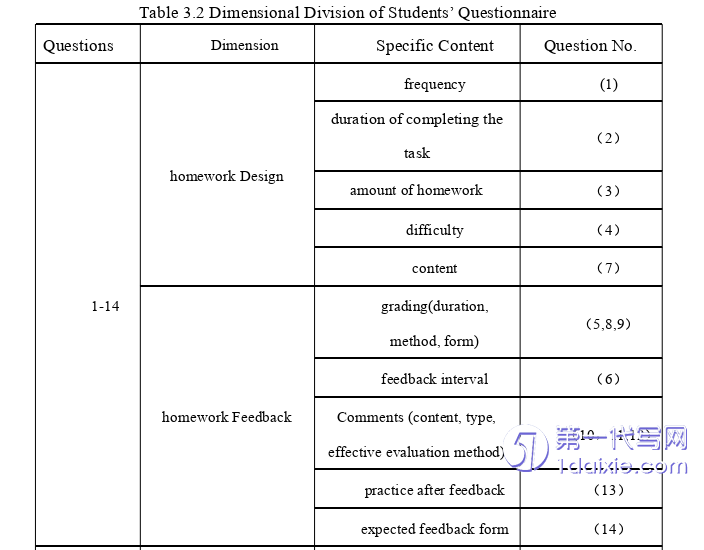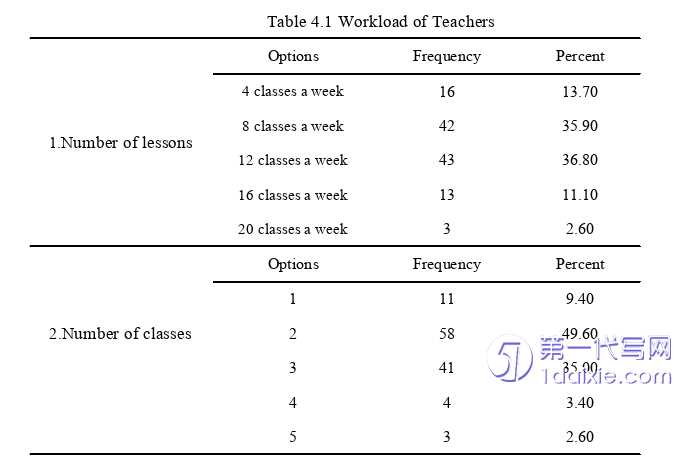本文是一篇英语论文,本研究提出以下建议:使用措施增强教师对作业设计和反馈的意识,促使教师在进行作业设计和反馈时聚焦于学生的全面发展,加强教师与学生之间的全过程沟通,对作业进行分层次设计,且制定系统的反馈程序,使用合适的评语类型。
Chapter One Introduction
1.1 Background
The relevant departments of national education show high attention to homework,especially towards the compulsory education stage.They have issued multiple educationpolicies,among which the most widely disseminated and impactful one is the Opinions onFurther Reducing the Homework and Training Burden of Students in the CompulsoryEducation Stage,known as the“Double Reduction”initiative released by the General Officeof the CPC Central Committee and the General Office of the State Council in July 2021.Thisinitiative aims to enhance educational quality,implement moral education,prioritizehomework reform,advocate for thought-out,principled,and goal-oriented reduction ofstudent homework,and continually stress the need for more scientifically and reasonablyassigned homework.In the context of the Double Reduction,it becomes particularly importantto enhance the quality and effectiveness of homework while reducing its volume.Meanwhile,timely and appropriate feedback on homework is a crucial aspect.Education Minister ChenBaosheng emphasized the importance of timely homework feedback in his speech at theNational Education Conference in January 2021.In April of the same year,the Ministry ofEducation issued a notice on Strengthening the Management of Homework in CompulsoryEducation Schools,emphasizing the importance of making feedback more prompt andconsistent.It was highlighted that teachers must thoroughly correct and provide feedback onassigned student homework,not allowing self-correction by students,and reinforcing theeducational function of homework correction and feedback.homework correction should beconducted with accuracy,correctness,and appropriate comments to analyze students’learningsituations precisely,providing targeted and timely feedback through methods like collectivereviews and individual explanations,particularly strengthening assistance for students facinglearning difficulties.

1.2 Purpose
This thesis focuses on the English homework of students from a certain junior highschool in Wuhan,employing questionnaire and interview.It investigates the current situationof homework design,including sources,frequency,workload,and current situation offeedback,including the feedback methods,content of comments,application of feedbackresults,as well as teachers’and students’attitudes and opinions towards students’homeworkdesign and feedback,aiming to identify issues in homework design and feedback.Subsequently,the thesis aims to provide recommendations for effective homework design andfeedback,offering guidance for teachers on how to enhance the implementation effectivenessin homework design and feedback and strengthen the inherent function of promoting theinteraction between teaching and learning through homework.
Chapter Two Literature Review
2.1 Key Terms
2.1.1 Homework
The Practical Education Comprehensive Dictionary defines homework as learningactivities that students undertake on their own to accomplish learning tasks,both in-class andoutside of class.It is frequently utilized to reinforce,internalize,comprehend,or applyknowledge acquired during lessons,playing a significant role in the teaching process.Out-of-class homework refers to the learning activities that students independently engage inoutside of class time according to the teacher’s requirements.The Educational Encyclopediaalso categorizes homework into classroom homework and out-of-class homework.Out-of-class homework is described as learning activities that students independentlyundertake outside of class time according to the teacher’s requirements.It is a form ofinstructional organization that helps consolidate and enhance the knowledge and skillsacquired by students in class,and cultivates students’independent learning abilities and studyhabits.Due to the fact that the Circular of the General Office of the Ministry of Education onStrengthening Homework Management in Compulsory Education Schools is primarilydirected at written homework,and the Opinions on Further Reducing the Homework Burdenand Training Burden for Students in Compulsory Education specifically addresses thequantity of written homework assigned to students at home so that this thesis predominantlyfocuses on written homework.The definitions provided above regarding homework allincorporate similar elements,that is,homework is learning activity that is intended to beindependently completed by students outside of regular class hours.
2.2 Previous Studies of Homework at Home and Abroad
The emphasis of domestic and international scholars on research related to homework,homework design,and homework feedback varies.This chapter presents the research findingsof domestic and international scholars on homework,homework design,and homeworkfeedback.
2.2.1 Previous Studies Abroad
2.2.1.1Previous Studies on Homework Abroad
Educators abroad have a wealth of scholarship on homework research.For the types ofhomework,Cooper(1989)categorized homework into two types which are no-changehomework and homework requiring preparation.The former examines mechanicalmemorization and the latter examines high-level thinking skills.
Several scholars have conducted multi-faceted research on the relationship betweenhomework and student performance,particularly focusing on the quantity of homework.Bonyun(1992)reviewed previous studies on homework to explore the relationship betweenstudent grades and homework completion volume and he concluded that there exists apositive correlation between the volume of homework completed and student grades.However,other scholars have pointed out that there is an optimal range for homework volume,and exceeding this range may not be beneficial for improving student performance.Cooper(2006)studied the impact of homework from the perspectives of time allocation andhomework volume.He argued that the influence of homework on students could be relative,either positive or negative,with the key lying in the quality and quantity of homework.Weston(1999)also had a similar finding,indicating that there is a curvilinear relationshipbetween time for completion of homework and student grades.
Chapter Three Methodology................................29
3.1 Research Questions..........................29
3.2 Participants.........................................29
3.3 Instruments...........................................30
Chapter Four Results and Discussion........................................40
4.1 The Current State from Teachers’Perspective.........................40
4.1.1 Results of Questionnaire..............................40
4.1.2 Results of Interview.........................................50
Chapter Five Conclusion.......................................79
5.1 Major Findings.................................................79
5.1.1 Homework Design..................................................79
5.1.2 Homework Feedback.....................................80
Chapter Four Results and Discussion
4.1 The Current State from Teachers’Perspective
4.1.1 Results of Questionnaire
4.1.1.1 Homework Design
(1)Current Situation of Homework Design
In the teacher questionnaire,the following questions primarily aim to explore the currentworkload of teachers by examining the number of lessons,the number of classes,and thenumber of students.The frequency of different options chosen by the teachers will beprocessed,and the analysis of most teachers’current work content and workload wasconducted based on the proportions.The data is as follows in the table below:

Chapter Five Conclusion
5.1 Major Findings
5.1.1 The Current State from Teachers’Perspective
Regarding the current situation of homework design,teachers’philosophies andsatisfaction levels are as follows:Teachers generally expressed that the purpose of assigninghomework is to solidify the effect of student learning through the application of acquiredknowledge,and the completion of homework allows both teachers and students to clearlyunderstand the students’current grasp of the knowledge.The teachers were focused onacademic purposes and lack attention to non-academic purposes.In choosing sources forhomework content,most teachers believed that the current commonly used textbooks,workbooks,and English learning newspapers are quite capable of meeting the learning needsof students because the content in the textbooks and workbooks is closely related to thelearning exercises of the day.When designing English homework,teachers mainly consideredwhether the homework content matches the main content learned in class and the individualdifferences among students.Teachers have scarcely considered diversifying the types ofquestions and the content.Under the background of the Double Reduction policy,teachersalso considered the quantity of homework when designing it.Teachers believed that studentscan complete their homework in about half an hour.Most teachers are satisfied with thecurrent situation of homework design because they knew the progress of students throughtheir performance in completing homework,and the effect of homework promoting learningis noticeable.For future improvements in homework design,teachers have suggested reducingthe quantity of homework,designing it in tiers,and increasing its interest and scientific natureto promote the cultivation of students’thinking and moral character.
reference(omitted)
